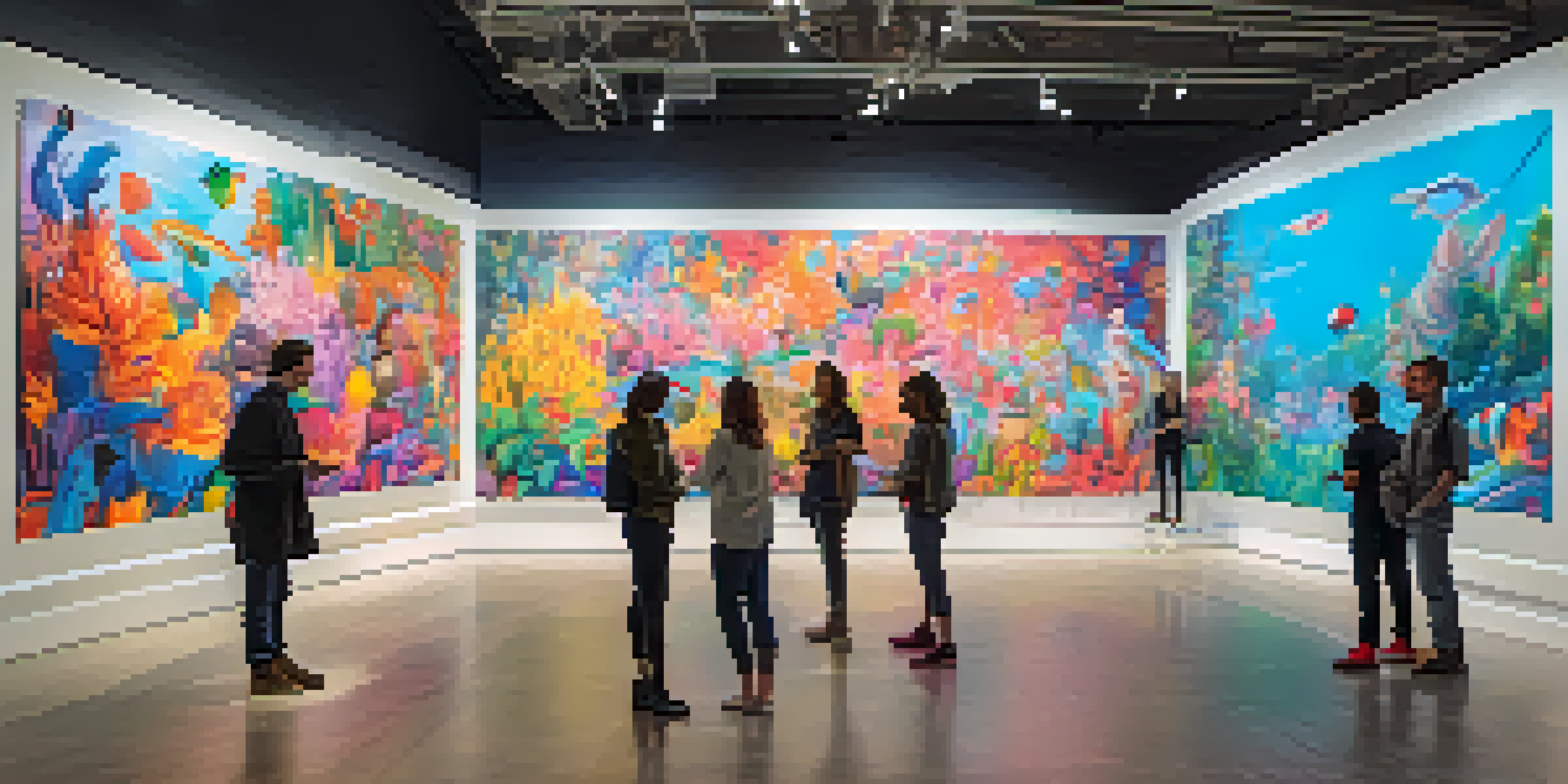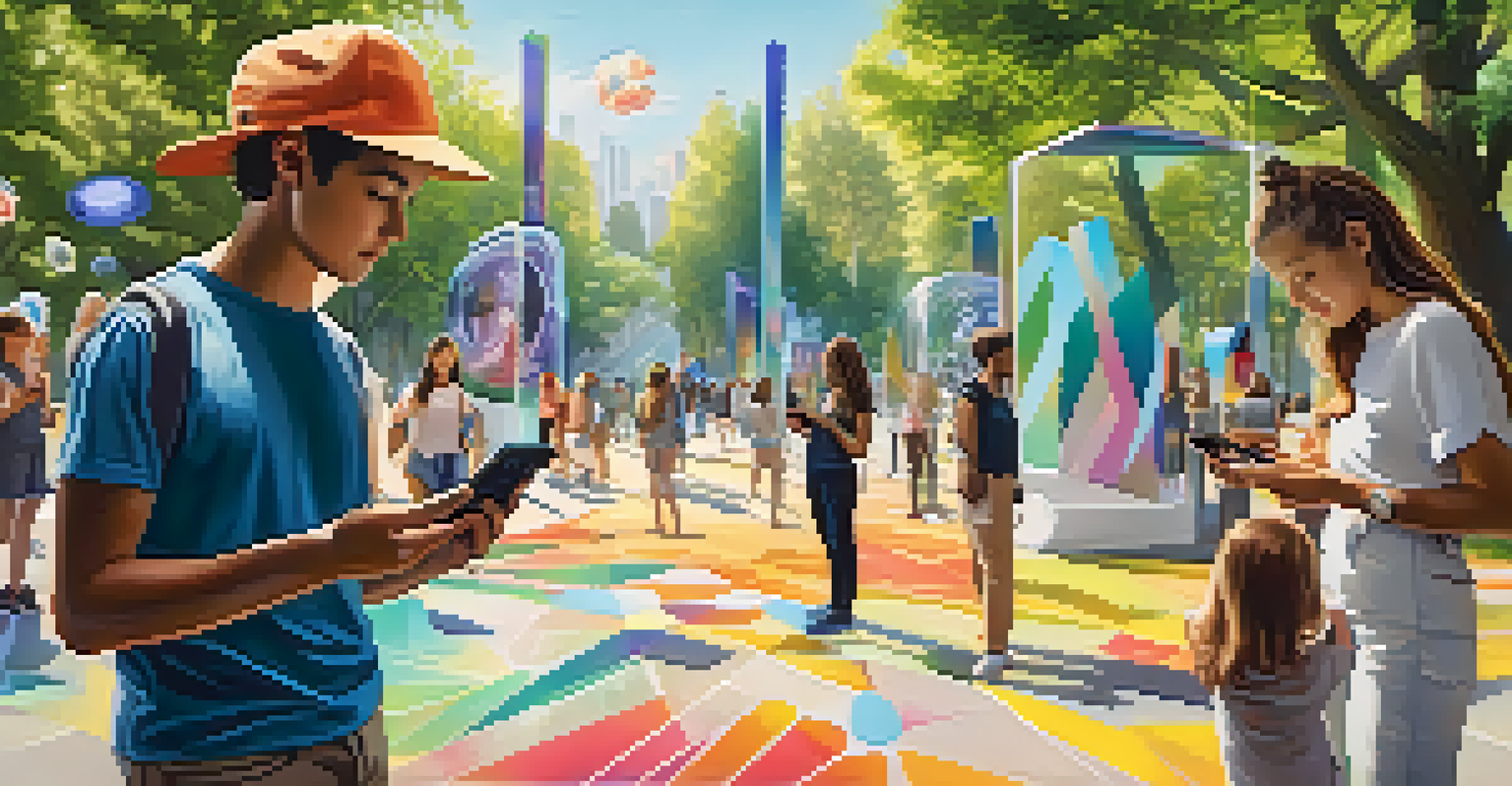Augmented Reality in Digital Art: Expanding Creative Boundaries

Understanding Augmented Reality in Art
Augmented reality (AR) merges the physical and digital worlds, creating a unique experience for users. In the context of digital art, AR provides artists with an innovative tool to enhance their creations. Imagine walking through a gallery and seeing a painting come to life right before your eyes—this is the magic of AR.
Art is not freedom from discipline, but disciplined freedom.
At its core, AR overlays digital information onto the real world, allowing viewers to interact with art in ways that were previously unimaginable. For instance, an artist might use AR to add layers of visual storytelling to a static piece, inviting the audience to engage and interpret the work differently. This interactivity can evoke emotions and provoke thoughts, making art more accessible and enjoyable.
As more artists embrace AR, they expand their creative boundaries, pushing the limits of traditional art forms. The fusion of technology and artistic vision not only enhances the viewing experience but also redefines what art can be. This evolution encourages artists to experiment and innovate, ultimately enriching the art community.
Innovative Tools for Artists
The rise of AR technology has given artists access to an array of tools that were once limited to the realms of science fiction. Software like Adobe Aero allows creators to design immersive experiences without needing extensive coding skills. This democratization of technology means that anyone with a vision can now bring their ideas to life.

Moreover, AR art applications are becoming increasingly user-friendly, enabling artists to focus on their creativity rather than getting bogged down by technical challenges. For example, an artist can simply use their smartphone to create AR animations that complement their physical artworks. This ease of use is encouraging more creators to explore the possibilities of augmented reality.
AR Transforms Artistic Expression
Augmented reality merges the physical and digital worlds, allowing artists to enhance their creations and engage audiences in new ways.
As artists experiment with these innovative tools, they discover new ways to express their ideas, often leading to collaborations with technologists and designers. This synergy between art and technology fosters a vibrant creative ecosystem, where the only limit is the artist’s imagination.
Engaging Audiences with Interactive Art
One of the most exciting aspects of AR in digital art is its ability to engage audiences in interactive experiences. Instead of passively observing, viewers can become active participants in the artwork. For instance, an installation might allow attendees to use their smartphones to unlock hidden layers or narratives within a piece, creating a deeper connection to the art.
The best artist has no conception that a marble block does not contain within itself. It is the task of the artist to reveal it.
This level of interactivity can transform the way people perceive and appreciate art. It encourages curiosity and exploration, prompting viewers to ask questions and seek out meaning. A simple static piece can become a multi-dimensional experience, inviting conversations and insights that enhance cultural understanding.
Furthermore, the social aspect of AR art cannot be overlooked. As individuals share their experiences on social media, they help to amplify the artist's reach and engage new audiences. This communal sharing fosters a sense of belonging and encourages conversations around art, making it a more inclusive space.
Case Studies of AR in Digital Art
Several artists have successfully integrated AR into their work, showcasing the potential of this technology. For example, the artist Refik Anadol uses AR to create stunning visualizations that blend data and art, allowing viewers to experience the beauty of information in a tangible way. His projects often challenge traditional notions of what art can communicate.
Another notable instance is the 'The Night Cafe' project, which takes audiences on a virtual journey through Vincent van Gogh's iconic painting. By combining AR with virtual reality, viewers can step inside the artwork, exploring its colors and textures like never before. This immersive experience breathes new life into a classic, making it relevant to contemporary audiences.
Innovative Tools Empower Artists
Technological advancements in AR provide artists with user-friendly tools, enabling them to create immersive experiences without extensive technical skills.
These case studies not only highlight the creativity of artists but also demonstrate the versatility of AR as a medium. They inspire other creators to experiment and push the boundaries of their own artistic practices, leading to a flourishing environment for innovative expressions.
Challenges and Considerations for Artists
Despite the numerous benefits of AR in digital art, artists face challenges in adopting this technology. One significant hurdle is the cost of equipment and software, which can be prohibitive for emerging artists. Additionally, the rapid pace of technological change means that artists must continually adapt and learn new skills, which can be overwhelming.
Another consideration is the accessibility of AR experiences. While many people have smartphones capable of running AR applications, there are still significant barriers for those without access to this technology. Artists must think critically about how to ensure their work is inclusive and can reach a diverse audience.
Lastly, the ephemeral nature of digital art in an AR context raises questions about permanence and ownership. Artists must navigate the complexities of digital rights and the implications of their work existing in a constantly changing digital landscape. These challenges require careful thought and planning as artists step into the world of augmented reality.
The Future of AR in Digital Art
As technology continues to evolve, the future of AR in digital art looks promising. With advancements in hardware and software, artists will have even more powerful tools at their disposal. This could lead to richer, more complex experiences that challenge viewers' perceptions and push the boundaries of creativity.
Moreover, the potential for collaboration between artists and technologists will likely increase, resulting in groundbreaking works that blur the lines between various artistic disciplines. Imagine a performance artist using AR to enhance their live shows or a sculptor creating pieces that change shape and form based on viewer interaction.
Interactive Art Engages Audiences
AR facilitates interactive experiences that invite viewers to actively participate in the artwork, fostering deeper connections and cultural conversations.
Ultimately, the future of AR in digital art is about exploration and experimentation. As artists continue to embrace this technology, we can expect to see a vibrant fusion of art and technology that captivates audiences and inspires future generations. The possibilities are endless, limited only by the imagination of those who dare to dream.
Conclusion: Embracing New Realities in Art
Augmented reality is not just a passing trend; it's a transformative force in the world of digital art. By merging the physical and digital realms, AR opens up new avenues for artistic expression and audience engagement. Artists who embrace this technology are not only expanding their creative boundaries but are also redefining the role of art in society.
As we move forward, it's essential for artists, technologists, and audiences to collaborate and explore the potential of AR together. This collaboration can foster innovation and lead to exciting developments that enhance our understanding and appreciation of art. The journey into augmented reality is one of discovery and creativity.

In conclusion, as augmented reality continues to evolve, its impact on digital art will only grow. By embracing new realities, artists can create immersive experiences that resonate deeply with audiences, transforming how we interact with art in the modern world. The future of art is bright, and augmented reality is at the forefront of this exciting movement.